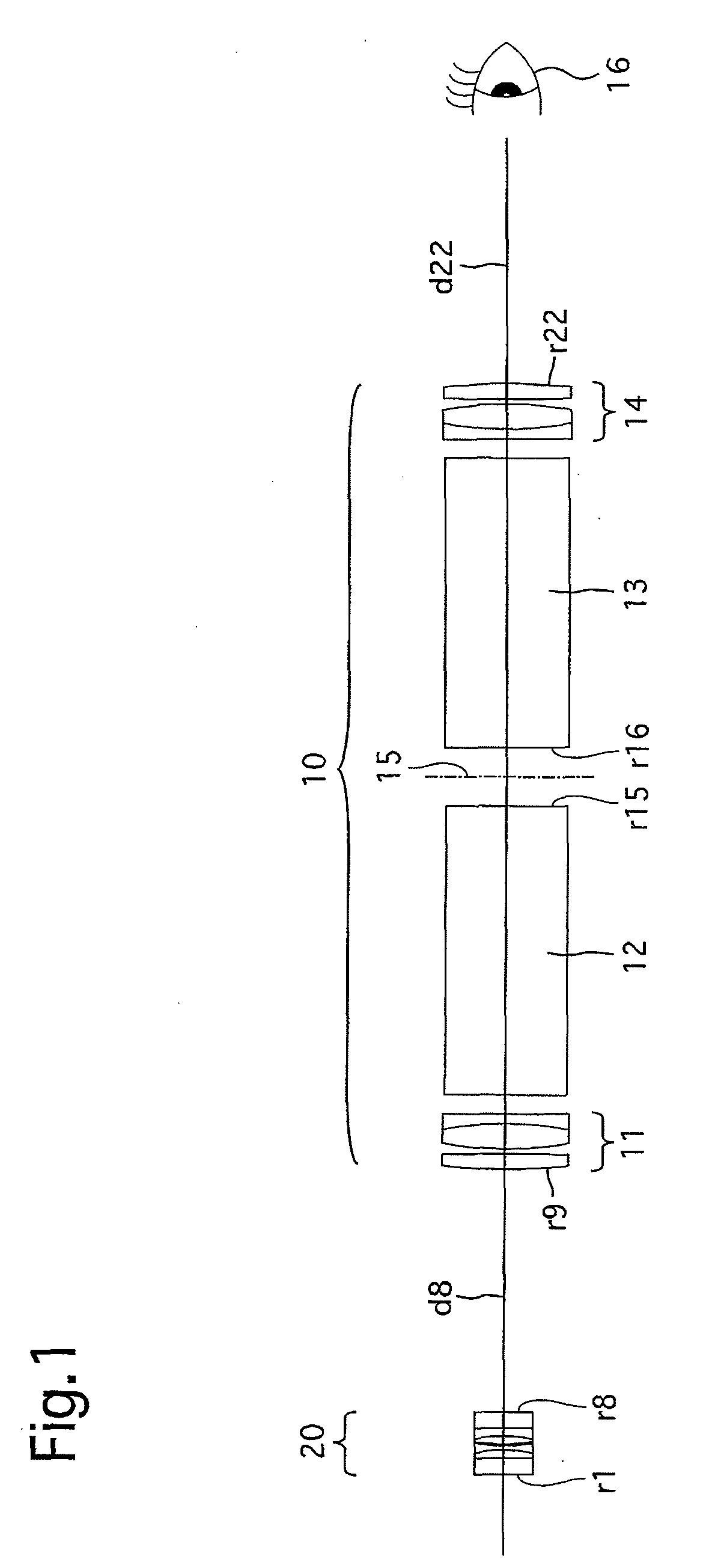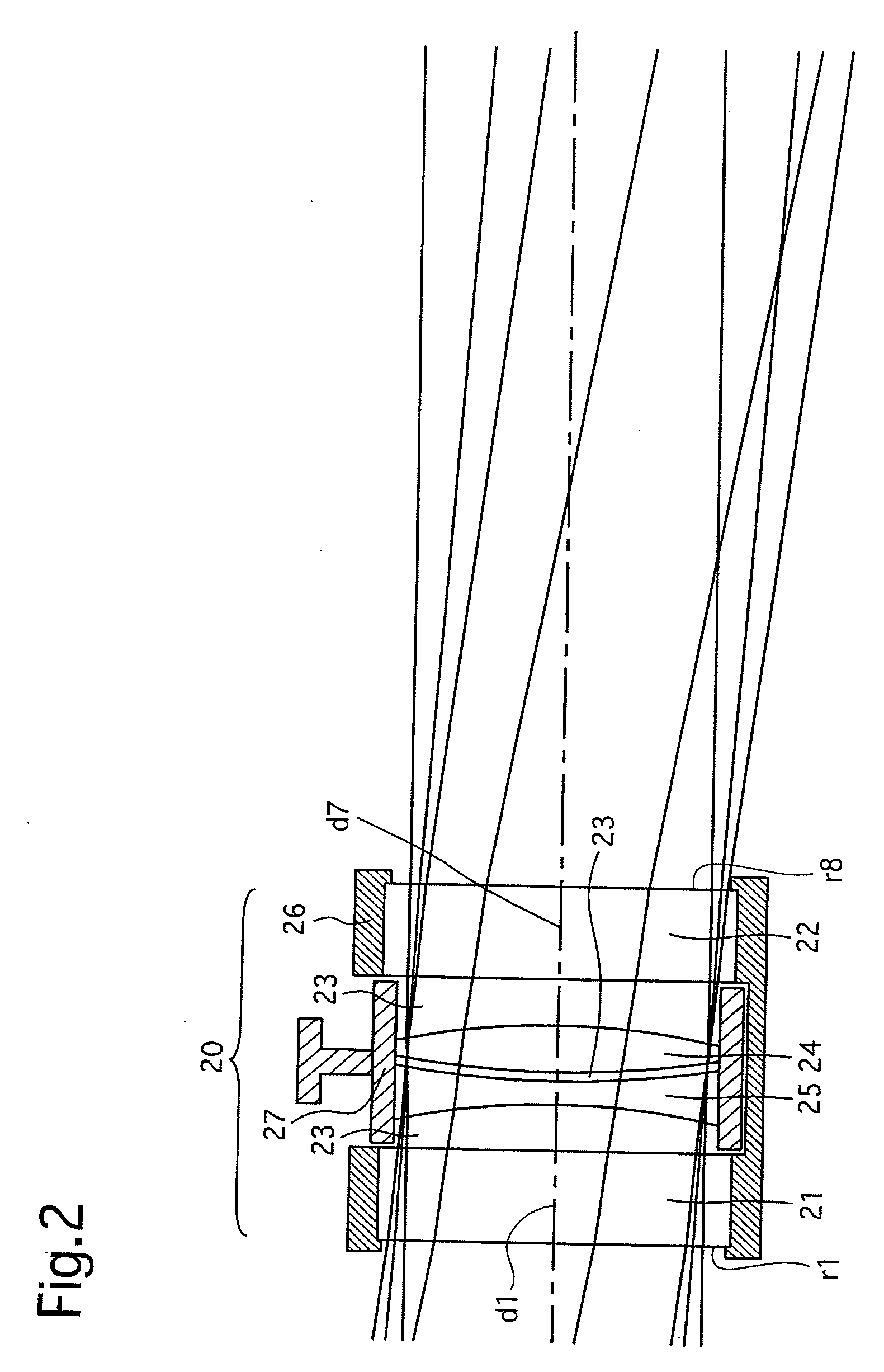Multifocal intraocular lens simulator and method of simulating multifocal intraocular lens
a multi-focal intraocular lens and simulator technology, applied in intraocular lenses, medical science, diagnostics, etc., can solve the problems of deterioration in visibility, halo (optical phenomenon) tending to occur around the refractive multifocal intraocular lens, and the disadvantage of highlight glar
- Summary
- Abstract
- Description
- Claims
- Application Information
AI Technical Summary
Benefits of technology
Problems solved by technology
Method used
Image
Examples
first embodiment
[0066]FIGS. 1 and 2 show an optical system provided in a first embodiment of a multifocal IOL simulator according to the present invention. The optical system of the multifocal IOL simulator is provided with an afocal optical system 10, the angular magnification of which is approximately 1 (1.0×) and an IOL holder (test lens holder) 20 positioned at the entrance pupil of the afocal optical system 10. The afocal optical system 10 is designed such that parallel rays (rays from an infinite object) entering the afocal optical system 10 are also substantially parallel when emerging therefrom.
[0067]The afocal optical system 10 is provided with an objective lens group 11 having positive power, a first prism 12, a second prism 13 and an eyepiece lens group 14 having positive power, in that order from the object side. An image plane 15 is formed between the first prism 12 and the second prism 13. The objective lens group 11 and the first prism 12, and the second prism 13 and the eyepiece len...
numerical embodiment 1
[0072]TABLE 1 below shows lens data in Numerical Embodiment 1 for the optical system shown in FIG. 1. In each of TABLES 1, 2 and 4 through 8, NO designates the surface number counted from the object side, R designates the radius of curvature, d designates the lens-element thickness or the distance between lens elements (lens groups), N(d) designates the refractive index at the d-line, and v designates the Abbe number. The unit of R and the unit of d are mm (millimeters). The surface numbers 1 through 8 designate surfaces of the IOL holder 20 (the surface numbers 5 and 6 designate surfaces of the multifocal IOL 24), and the surface numbers 9 through 22 designate surfaces of the afocal optical system 10. The angle of incidence of light on the IOL holder 20 (angle of incidence of light on the afocal optical system 10) is ±10 degrees.
TABLE 1NORdN(d)ν1∞2.0001.5163364.12∞1.0001.33304(water)55.83−13.650.5001.4917657.4Compensator Lens417.90.2001.33304(water)55.8517.91.0001.4917657.4IOL (20D...
second embodiment
[0074]FIG. 3 shows an optical system provided in a second embodiment of the multifocal IOL simulator according to the present invention. The optical system of this multifocal IOL simulator is provided with an afocal optical system 30, the angular magnification of which is approximately 1 and an IOL holder (test lens holder) 20 positioned at the entrance pupil of the afocal optical system 30. An observer's eye 16 is positioned at the exit pupil of the afocal optical system 30. The IOL holder 20 in the second embodiment of the multifocal IOL simulator is identical to that in the first embodiment of the multifocal TOL simulator.
[0075]The afocal optical system 30 is provided with two Keplerian afocal optical systems 31 and 32 which are symmetrically arranged. In this embodiment, the two Keplerian afocal optical systems 31 and 32 are configured from a pair of binocular optical systems (a pair of erecting binocular telescopes). The Keplerian afocal optical system 31, which is positioned t...
PUM
 Login to View More
Login to View More Abstract
Description
Claims
Application Information
 Login to View More
Login to View More - R&D
- Intellectual Property
- Life Sciences
- Materials
- Tech Scout
- Unparalleled Data Quality
- Higher Quality Content
- 60% Fewer Hallucinations
Browse by: Latest US Patents, China's latest patents, Technical Efficacy Thesaurus, Application Domain, Technology Topic, Popular Technical Reports.
© 2025 PatSnap. All rights reserved.Legal|Privacy policy|Modern Slavery Act Transparency Statement|Sitemap|About US| Contact US: help@patsnap.com



